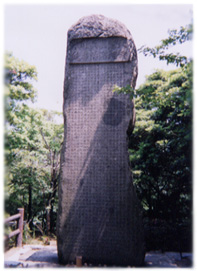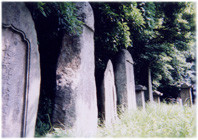
 |
The Epitaph of Miyamoto Musashi -The Kokura Hibun Built by his first adopted son Iori in memory of his father. Ogasawara Tadazane was lord of Banshu, Akashi, (present day Hyogo prefecture). Ogasawara Tadazane came to Kokura in 1632 and brought Iori with him. Iori had served under the lord since 1626 at the age of fifteen. Although still only twenty one years of age, Ogasawara had made him one of his chief retainers giving him 2500 koku. Readers may be familiar with the Ogasawara family through Ogasawara Ryu Kyudo and the reiho (etiquette) as taught in Japan. Nowadays etiquette has altered somewhat. The Hyoho Niten Ichiryu use the original system of etiquette. Musashi lived in Kokura as a guest of the Lord Ogasawara from 1634 to 1640. |
He then moved to Kumamoto as a guest of the Lord Hosokawa Tadatoshi. He died there on March 19th 1645
This monument on Mount Tamuke (also known as Musashiyama) was completed on March 19th 1654. The mountain had been given to Iori by Ogasawara Tadazane. Written on the stone is a funeral eulogy. His life and battles Musashi had fought. A record of his life written in stone.
It remains as one of the most famous in the Kita Kyushu area. The epitaph on the monument notes the achievements of Musashi as a swordsman, and was written by Shuzan, a priest of the Ta Sho Temple in Kumamoto Prefecture. He and Miyamoto Musashi had been intimate friends.
I have not included his achievments as they can be read about in books and on other web sites.
 |
The Grave of Iori Miyamoto. He had died in 1678 at the age of 67. Below is a photograph of this and other descendants. In all an unbroken line of twelve generations of the Miyamoto family have live in Kita Kyushu. Eleven in Kokura, the present generation living in Moji. Another unbroken tradition is the fact that all of including the present generation retain the name Iori. These graves are also on Mount Tamuke but had been moved to a safe secluded part of the mountain in Meiji 22 (1890) by the Japanese government when they built fortifications on the top because of the Nishin Senso (war against China). |
Entering Tatsutayama Koen in Kumammoto one will see various tombs dedicated to the Hosokawa Lords Shodai Hosokawa Fujitaka, Nidai Hosokawa Tadaoki, Yondai Hosokawa Mitsunao Also the tomb of Hosokawa Garcia can be seen. She was the wife of Hosokawa Tadaoki. Her father Akechi Mitsuhide had been enlisted by Hosokawa to asassinate Oda Nobunaga worried that with his obsession to rule over Japan he might even kill the emperor.To avoid being taken a hostage by Ishida she wrote the following death poem and commited ritual suicide. "As blossoms fall I see my fate In this world blossoms pass away And so must we" |
Gorin no To One moves to the left of the Hosokawa Tombs to walk to a small family graveyard. Here can be found the grave of Musashi and next to it his friend the preist Haruyama. Why the name Gorin no Sho? This particular grave copies the shape of stupa in Tibet and is known as Gorin no To. The shapes of the stones represents the five elements of Earth, Water, Fire, Wind, Void. Don't try to translate the kaji on the grave, It's Sanskrit. Kokura has a long history or armaments building. Had the second atomic bomb been dropped on its decided destination, we would not be able to view this monument and the graves today. There are documents and geneology relating to Musashi written by Miyamoto Iori and handed down to the present generation. |
